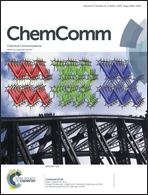A survey of advancements in nucleic acid-based logic gates and computing for applications in biotechnology and biomedicine
Abstract
Nucleic acid-based logic devices were first introduced in 1994. Since then, science has seen the emergence of new logic systems for mimicking mathematical functions, diagnosing disease and even imitating biological systems. The unique features of nucleic acids, such as facile and high-throughput synthesis, Watson–Crick complementary base pairing, and predictable structures, together with the aid of programming design, have led to the widespread applications of nucleic acids (NA) for logic gate and computing in biotechnology and biomedicine. In this feature article, the development of in vitro NA logic systems will be discussed, as well as the expansion of such systems using various input molecules for potential cellular, or even in vivo, applications.

- This article is part of the themed collection: Molecular Logic Gates and Information Processing


 Please wait while we load your content...
Please wait while we load your content...